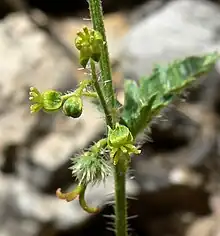| Tragia ramosa | |
|---|---|
 | |
| Scientific classification | |
| Kingdom: | Plantae |
| Clade: | Tracheophytes |
| Clade: | Angiosperms |
| Clade: | Eudicots |
| Clade: | Rosids |
| Order: | Malpighiales |
| Family: | Euphorbiaceae |
| Genus: | Tragia |
| Species: | T. ramosa |
| Binomial name | |
| Tragia ramosa | |
Tragia ramosa is a species of flowering plant in the spurge family known by the common names branched noseburn,[1] and desert tragia.
It is native to the southern Great Plains, South Central, and Southwestern United States and Northern Mexico. It grows in scrub, woodland, and other desert and plateau habitat.
Description
Tragia ramosa is a perennial herb growing mostly erect, measuring 10 to 30 centimeters in maximum height. It is covered in long, rough stinging hairs.[2] The leaves have lance-shaped or oval blades with toothed edges, which are borne on petioles.
The plant is monoecious. Its inflorescence contains a few male flowers and usually one female flower. The flowers lack petals but have green sepals.
The female flower yields a small capsule.
References
- ↑ USDA, NRCS (n.d.). "Tragia ramosa". The PLANTS Database (plants.usda.gov). Greensboro, North Carolina: National Plant Data Team. Retrieved 14 December 2015.
- ↑ Thurston, E. L. (1976). Morphology, fine structure and ontogeny of the stinging emergence of Tragia ramosa and T. saxicola (Euphorbiaceae). American Journal of Botany 63:6 710-18.
External links
![]() Media related to Tragia ramosa at Wikimedia Commons
Media related to Tragia ramosa at Wikimedia Commons